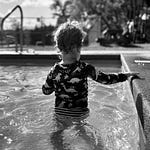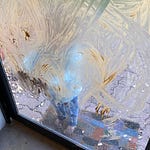Welcome to July. In honor of Cleft-Craniofacial Awareness Month, I am sharing this post about a community I was so privileged to work with for a number of years. This post was originally published last July on a previous blog and Linkedin. It’s had a little refresh editing and I am so happy to be able to share it in this space. Let me introduce you to some of the people I was so lucky to meet.

This is a glimpse of a community I came to know during my role as an embedded psychologist on a multi-disciplinary cleft-craniofacial team at a pediatric hospital. July is Cleft-Craniofacial Awareness Month, so it is only fitting to share my memories from this time of my career. When I left my hospital position to stay at home full-time with my kids, leaving these people was by far the hardest part.
A new job, new knowledge
I did not have a logical career progression that led to joining the cleft-craniofacial team, because honestly, I stumbled into an opportunity. I had interviewed for another position that fell through and my soon-to-be boss shared that a role as an embedded psychologist on a multidisciplinary team had just come up. The psychologist would work with a team of surgeons, dental specialists, speech pathologists, audiologists, social workers, nurses, and advanced practice providers (APPs). The unique position would involve seeing children with cleft-craniofacial conditions from infancy to young adulthood. The children would encounter a range of medical interventions and ongoing medical care through the clinic. The psychologist would have the task of screening for developmental differences and mental health challenges, as well as providing psychological treatment for a wide range of concerns including ADHD, anxiety, depression, and coping with their medical condition. If the original position I had applied for had not become unavailable, it could have been different and I am certainly glad it became what it was.
I was excited to learn something new and that I did. Over my 7 years in the clinic, I learned about cleft-craniofacial conditions but more importantly, I learned about the people with these conditions and those who support them. I learned that cleft lip and palate are the most common birth defects in the United States. I learned about the many stages of treatment for these children which had to be tailored to their specific cleft and needs. Some children had one surgery and some had many. Beyond surgery, many children needed support around feeding, speech, and specialized dental/ orthodontic care. I learned about the broad range of craniofacial conditions impacting children. I met children with craniosynostosis, hemifacial microsomia, facial clefts, and genetic syndromes.
A cleft lip is a separation of the two sides of the lip, which often includes the bones of the upper jaw and/or the gum.
A cleft palate is an opening in the roof of the mouth where the two sides of the palate did not join together during development in utero.
The lip and palate develop separately so a child can have just a cleft lip, cleft palate, or both a cleft lip and palate.
A craniofacial difference being a visible, structural, and/or functional difference affecting the head and/or face.
I will never forget my first day of shadowing. The team members were in and out of the clinic rooms, rotating through the patient’s appointment. They would then bring their recommendations back to the rest of the team. A plan would form based on all of the team member’s different data points. For some children, these appointments were a routine yearly follow-up, much like a well-child visit but longer. For others, it may be a more complex appointment planning a future surgery. I had never witnessed anything like clinic. Watching these specialists, I was in awe of their knowledge. It wasn’t just the academic knowledge, which was impressive, but the knowledge of the individual patients and families. Some team members had been there during some of the most challenging times in the child’s life, supporting feeding in the NICU, surgery as babies, speech therapy, additional surgeries at older ages, ongoing orthodontic treatments, and potentially more surgeries as young adults.
A team of many
Beyond the team of providers in the clinic, many others played a critical role in this dynamic dance. From the first phone call to the graduation of a patient from the clinic, it is an impressive web of individuals who witness a child’s cleft-craniofacial journey. There are administrative staff responsible for the scheduling, the coordination of complex procedures, and bringing together the busy schedules of multiple specialists for one patient. The administrative staff are often the first to speak to a family when beginning their entry into the clinic. There are medical assistants who are tasked with guiding families into and through their appointments. There is the social work team which has the job of finding the impossible pieces to make it feasible for some families to get care. There are numerous phone calls fielded by the clinic nurse and APPs triaging, clarifying instructions, and providing reassurance and compassion. Outside the outpatient clinic, there is the surgical space, where an incredible number of people make up the before, during, and aftercare. This includes the inpatient teams caring for the children and families during their stay. There are innumerable footsteps of the APPs, residents, and fellows traveling the hospital corridors supporting families while in the hospital and preparing for their eventual discharge. Many individuals work together, directly and indirectly for the child’s care. Some are only present for short glimpses of a child’s journey and others for the duration of childhood, yet each person has an impact. It is not a perfect dance, there are missteps, miscommunications, and challenges but there are moments when healthcare works really beautifully.

The families and kids
And then there are the caregivers. They do not choose for these providers to be in their lives. A series of invisible events have brought them together. A child is born with a cleft-craniofacial condition and now they are brought into a relationship with this medical community for years. Having a child is complicated in itself without navigating unique medical needs. Some families travel long distances and have to navigate transportation challenges, housing instability, food insecurity, financial stress, and safety concerns in their neighborhoods. Some children have a complex constellation of health needs beyond their cleft palate or craniofacial condition. This means they are involved with numerous medical specialties and need to balance an often-changing medical picture.
Some families discover their child’s diagnosis in utero but many do not. For some, a difference is identified at birth, and for others, differences are not identified until later. Caregivers learn a new world full of medical jargon, multiple medical providers, and an unfamiliar landscape to traverse with their children. All caregivers have questions about their child’s future, independent of having physical differences but a cleft-craniofacial condition brings more questions. There are questions about the child’s health, as well as social and emotional development:
Will my child deal with bullying?
How do you deal with people staring?
What do I say when people ask questions?
I have heard countless difficult stories from families about the comments, questions, and actions of others. Typically, others’ questions are rooted in curiosity but even curiosity can be hurtful when unskilled and unwelcome. More often than not parents would report that it was not other children who do the most harm but adults. Everyone deserves to be seen as they are, a whole person treated with respect and kindness.
The children I met also loved Minecraft, baseball teams, candy, mischief, and Taylor Swift. Their caregivers had questions about toddler tantrums, potty training standoffs, helping kids deal with a difficult teacher, teens glued to their phones, and all the other questions that can show up as a child grows. Differences too often keep us from seeing how much we are the same.

The magic of this role
As a psychologist, we typically are in a person’s life for a brief snapshot, a moment in time. I had the unique opportunity to see these kids grow and change. As kids are, they often wouldn’t remember me but I remembered them. Now that I no longer work at the clinic, my days are very different. My Mondays do not involve a busy clinic that always has more patients than expected and therefore my feet hurt less on Monday nights. I have had the time to step back and metabolize this part of my life and attempt to put words to it, although somehow, they still fall short. The privilege of revisiting these memories fills me with gratitude. Thank you to the people I have met: the team, the families, and most importantly the kids. Being there felt unexpected and also where I was supposed to be. I have a favorite quote about resilience from researcher Ann Masten’s book Ordinary Magic:
“The biggest surprise that emerged from the study of children who overcame adversity to become successful youth and adults in society was the ordinariness of the phenomenon.” (Masten, 2001).
Being in the cleft-craniofacial clinic I was able to witness ordinary magic daily and for that, I will always be grateful.
This is written in loving memory of Jane Alcorn (1957-2021), our clinic nurse who was so much more, including the clinic “mom” for our team and our families. She was a compassionate soul who loved that she was a part of these patients’ lives. She is greatly missed.
For more information about Cleft-Craniofacial conditions please visit the American Cleft Palate Association
As always—Just a little reminder: The content on Mindful Mom in the Mud posted by Dr. Kathryn Barbash, PsyD on the Instagram account (@drkathrynbarbash), YouTube channel (@mindfulinthemud) and newsletter (mindfulinthemud.substack.com) or any other medium or social media platform is for educational purposes only and is not intended to be a substitute for medical, clinical, legal and professional advice, diagnosis or treatment. Reliance on any information provided by Mindful Mom in the Mud is solely at your own risk. Always seek the advice of your licensed mental health professional or other qualified health provider.
Thanks for reading. If you are enjoying compassionate, common sense writing about parenthood, hit the heart button, leave a comment, share with a friend, or restack on Substack notes. It helps other readers navigating the mess of parenthood find the newsletter.












The Magic of Meeting People